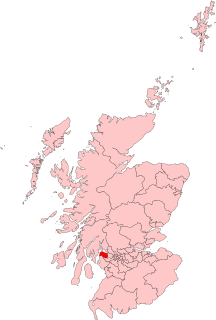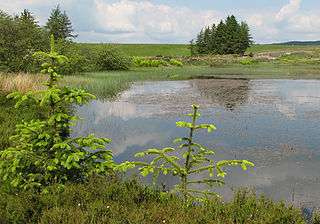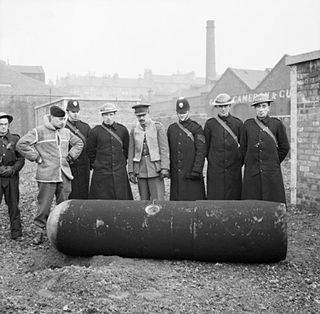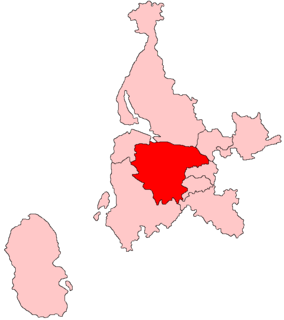
Inverclyde is one of 32 council areas used for local government in Scotland. Together with the East Renfrewshire and Renfrewshire council areas, Inverclyde forms part of the historic county of Renfrewshire, which currently exists as a registration county and lieutenancy area - located in the west central Lowlands. It borders the North Ayrshire and Renfrewshire council areas, and is otherwise surrounded by the Firth of Clyde.

Greenock is a town and administrative centre in the Inverclyde council area in Scotland and a former burgh within the historic county of Renfrewshire, located in the west central Lowlands of Scotland. It forms part of a contiguous urban area with Gourock to the west and Port Glasgow to the east.

Port Glasgow is the second-largest town in the Inverclyde council area of Scotland. The population according to the 1991 census for Port Glasgow was 19,426 persons and in the 2001 census was 16,617 persons. The most recent census in 2011 states that the population has declined to 15,414. It is located immediately to the east of Greenock and was previously a burgh in the county of Renfrewshire.

Inverclyde is a parliamentary constituency of the House of Commons of the Parliament of the United Kingdom. It replaced Greenock and Inverclyde and the Port Glasgow and Kilmacolm areas from West Renfrewshire for the 2005 general election.

Loch Thom is a reservoir which since 1827 has provided a water supply to the town of Greenock in Inverclyde, Scotland. It is named after the civil engineer Robert Thom who designed the scheme which created the reservoir and delivered water via a long aqueduct known as The Cut. Today, as well as providing a water supply, the loch is used for sport fishing and forms part of the Clyde Muirshiel Regional Park with several attractive walks and a centre at Cornalees Bridge providing nature study facilities.

The Gryffe Reservoirs, also splled 'Gryfe', take their name from the River Gryffe, name deriving from the Gaelic garbh meaning "rough stream". are two reservoirs, known as Gryffe No. 1 and Gryffe No. 2, located in Inverclyde in the west central Lowlands of Scotland.

Inverkip is a village and parish in the Inverclyde council area and historic county of Renfrewshire in the west central Lowlands of Scotland, 4 miles (6.4 km) southwest of Greenock and 9 miles (14.5 km) north of Largs on the A78 trunk road. The village takes its name from the River Kip. It is served by Inverkip railway station.

The Greenock Blitz is the name given to two nights of intensive bombing of the town of Greenock, Scotland by the Nazi German Luftwaffe during the Second World War. The raids over the nights of the 6 and 7 May 1941 targeted the shipyards and berthed ships around the town. The brunt of the bombing fell on residential areas. Over the two nights, 271 people were killed and over 10,200 injured. From a total of 180,000 homes nearly 25,000 suffered damage and 5,000 were destroyed outright.

Renfrewshire or the County of Renfrew is a historic county, registration county and lieutenancy area in the west central Lowlands of Scotland. It contains the local government council areas of Inverclyde, Renfrewshire and East Renfrewshire, as well as parts of Glasgow and is occasionally named Greater Renfrewshire to distinguish the county from the modern council area.

Lyle Hill at the West End of Greenock, Inverclyde, Scotland, has scenic viewpoints accessible from Lyle Road which was constructed in 1879–1880 and named after Provost Abram Lyle, well known as a sugar refiner. The hill's highest point is Craigs Top at 426 feet above sea level, and before the road was constructed the hill was known as the Craigs, or as the Bingens.

Bouverie is an area of the town of Port Glasgow, Inverclyde, Scotland.

West Renfrewshire was a constituency of the Scottish Parliament (Holyrood). It elected one Member of the Scottish Parliament (MSP) by the first past the post method of election. Also, however, it is one of nine constituencies in the West of Scotland electoral region, which elected seven additional members, in addition to nine constituency MSPs, to produce a form of proportional representation for the region as a whole.
Wellington Academy was a secondary school at Dempster Street in Greenock, Scotland serving the Eastern and Central areas of the town. In 2007 it merged with Greenock High School to form Inverclyde Academy.
St Columba's High School is a co-educational six-year Roman Catholic, comprehensive secondary school, located next to Tower Hill Gourock, Inverclyde, Scotland. The school serves south west Greenock, Gourock, Inverkip and Wemyss Bay. The current enrolment (2018) is 682 pupils.

Clyde Muirshiel Regional Park is the collective name for areas of countryside set aside for conservation and recreation on the South Clyde estuary in Scotland.
Woodhall is a housing scheme in the lower east end of Port Glasgow, Inverclyde in Scotland. It stands on land once occupied by Woodhall mansion and estate. The mansion stood where St Martin's church now stands on Mansion Avenue. Woodhall is on a north facing slope, overlooking the River Clyde and is bounded on the north by the River Clyde, on the south by Parkhill Avenue, on the west by Port Glasgow cemetery and on the east by what is now the Castlebank housing estate which is on the site of the former Broadfield Hospital.

The McLean Museum and Art Gallery is a museum and art gallery situated in Greenock, Inverclyde, Scotland. It is the main museum in the Inverclyde area and opened in 1876. Most notably it features an exhibition of items related to James Watt, the Greenock-born inventor, a Mummy Cartonnage from Herakleopolis Magna and a collection of British and Scottish art. The principal entrance to the museum is on Kelly Street, in the Greenock West area. The former Curator is Val Boa. The Watt Institution includes the Art Gallery, Watt Hall, Watt Library and Inverclyde Archives.
Fort Matilda is a suburb at the far western edge of Greenock, Scotland. Its name comes from a coastal battery built on Whiteforeland Point 1814–1819 to defend the River Clyde.
Robert Thom (1774-1847) was a Scottish civil engineer who worked upon major hydraulic projects on the Isle of Bute and Inverclyde. On Bute, he created aqueducts to increase the flow of water which powered the cotton mills there, so that their capacity was increased. This economic success resulted in him becoming the laird of Ascog. He then created a larger system to supply water power to Greenock. The reservoir is named after him — Loch Thom — and the supply aqueduct is known as the Greenock Cut. In the early 1800s, he designed the first water purification plant in Scotland.

The Watt Library or Watt Monument Library in Greenock, Scotland, opened on its current site in 1837 and was the direct descendant of the Greenock Library, a subscription library founded in 1783. It closed as a subscription library in 1971 and re-opened as a public facility in 1973 under the name of the Watt Library, specialising in Local History and Archives. The building was designed in the Gothic revival style by architect Sir Edward Blore and is a listed building. It has undergone recent refurbishment and re-opened in November 2019 as the Watt Institution, incorporating the McLean Museum Watt Lecture Hall and Inverclyde Archives.















